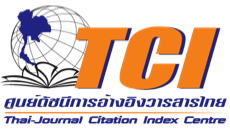การจัดการเรียนรู้ตามแนวสะเต็มศึกษาเพื่อส่งเสริมทักษะการคิดวิเคราะห์ และทักษะการคิดคำนวณวิชาวิทยาศาสตร์ของนักเรียนชั้นมัธยมศึกษาปีที่ 3 (STEM Education Learning Management for Encouraging Analytical Thinking Skills and Computational Thinking Skills in Science for Matthayomsuksa 3 Students)
คำสำคัญ:
สะเต็มศึกษา ทักษะการคิดวิเคราะห์ ทักษะการคิดคำนวณบทคัดย่อ
การวิจัยครั้งนี้มีวัตถุประสงค์ 1) เพื่อเปรียบเทียบทักษะการคิดวิเคราะห์ของนักเรียน ชั้นมัธยมศึกษาปีที่ 3 ระหว่างก่อนเรียนกับหลังเรียน โดยใช้การจัดการเรียนรู้วิทยาศาสตร์ตามแนวสะเต็มศึกษา 2) เพื่อเปรียบเทียบทักษะการคิดคำนวณของนักเรียนชั้นมัธยมศึกษาปีที่ 3 ระหว่างก่อนเรียนกับหลังเรียน โดยใช้การจัดการเรียนรู้วิทยาศาสตร์ตามแนวสะเต็มศึกษา ประชากร ได้แก่ นักเรียนชั้นมัธยมศึกษาปีที่ 3 วิทยาลัยนาฏศิลป สังกัดสถาบันบัณฑิตพัฒนศิลป์ กระทรวงวัฒนธรรมปีการศึกษา 2562จำนวน 676 คน กลุ่มตัวอย่างได้มาโดยการสุ่มแบบหลายขั้นตอน จำนวน 27 คน เครื่องมือที่ใช้ในการวิจัย คือ แผนการจัดการเรียนรู้วิทยาศาสตร์ตามแนวสะเต็มศึกษา แบบวัดทักษะการคิดวิเคราะห์ และแบบวัดทักษะการคิดคำนวณ สถิติที่ใช้ได้แก่ ค่าเฉลี่ย ค่าส่วนเบี่ยงเบนมาตรฐาน และการทดสอบค่าที ผลการวิจัยพบว่า 1) นักเรียนมีทักษะการคิดวิเคราะห์หลังได้รับการจัดการเรียนรู้วิทยาศาสตร์ตามแนวสะเต็มศึกษา สูงกว่าก่อนได้รับการจัดการเรียนรู้วิทยาศาสตร์ตามแนวสะเต็มศึกษาอย่างมีนัยสำคัญทางสถิติที่ระดับ .05 2) นักเรียนมีทักษะการคิดคำนวณหลังได้รับการจัดการเรียนรู้วิทยาศาสตร์ตามแนวสะเต็มศึกษา สูงกว่าก่อนได้รับการจัดการเรียนรู้วิทยาศาสตร์ตามแนวสะเต็มศึกษาอย่างมีนัยสำคัญทางสถิติที่ระดับ .05
เอกสารอ้างอิง
Routledge 711 Third Avenue.
Nuraarsekeen S. (2017). Effect of STEM Education on Chemistry Achievement, Analytical Thinking Ability and Instructional Satisfaction of Grade 10 Students. Princess of Narathivas University Journal of Humanitics and Social Science 4(1): 42-53. (in Thai)
Kamontip S. (2015). The Development of Learning Activities by the STEM Education to Promote Analytical Thinking on the Topic Momentum and Collision for grade 10 students. Independent Study M.Ed. in Curriculum and Instruction Naresuan University. (in Thai)
Pithoon, S et al. (2014). Anatysis thinking .. how to teach. 1st ed. Bangkok: Chulalongkorn University press. (in Thai)
Porntip, S. (2013). STEM Education and 21st century skills Development. SWU Educational Administration Journal 33(2): 49-56. (in Thai)
Porntiva T. (2012). The Development of Learning outcomes on addition substraction multiplication and division of integral numbers of Diploma in Accounting by Exercises Based. [Online]. Retrieved January 17, 2019, from http://www.payaptechno.ac.th/app/images/payap/qa/innovation/teacher.pdf. (in Thai)
Sirinapa K. (2015). STEM Education. Journal of Education Naresuan University 17(2): 201-207. (in Thai)
Somjitra R et al. (2007). Education Research and Statistics. 2nd ed. Bangkok: Academic promotion centre publishing house. (in Thai)
Taveesuk, J. (2017). 4.0 Education Management sustainable city. [Online]. Retrieved January 17, 2019, http://adacstou.wixsite.com. (in Thai)
The Mathematical Association of Thailand. (1994). The development computational thinking skills for elementary pupil. Bangkok: Chulalongkorn University. (in Thai)
The institute for the Promotion of Teaching Science and Technology. (2013). STEM Education. Bangkok: The institute for the Promotion of Teaching Science and Technology. (in Thai)
Visanee, A. (2016). Useful idea about STEM Education. 1st ed. Bangkok: Chulalongkorn University press. (in Thai)
Vimon T. (2013). The Development Analytical Thinking skills by use Graphic organizer Instructional Model for Grade 9 Students. Technology in Curriculum Research and Development Rajamangala University of Thechnology Thanyaburi. (in Thai)





